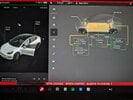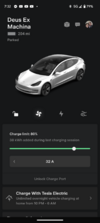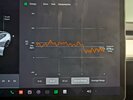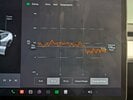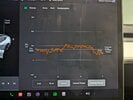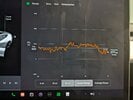Can you share how you know the information you know regarding the it's showing the delta not what's added?
You can verify yourself. Set the Amp limit to 4A or something so you can only get 1kW of charging, then run the heat on MAX for 15-30 minutes. That should take a couple kWh and reduce the number by that much. You can also just switch to miles and then you can see the miles added reduce pretty quickly. It's just looking at net energy added.
As far as the 4.5% off part, it just is what it is. It can be determined empirically through observation, or you can use ScanMyTesla and compare, to be definitive.
Attached are what I think you are asking for and it's as they are now, not during the time of OP.
You're missing the % and miles (important unless at 100% which you're not) unless somehow they were cut off during the posting process. Just see the sticky. Instant range is meaningless, delete those! You really just need the % but posting one with the rated miles is helpful for other reasons.
I think there are too many maybes aka guess work involved in something so essential and backed by a warranty to warrant some sort of change in how battery state/health is communicated, ideally change to remove the guess work and make things transparent.
Yeah, if you read around this forum you'll see plenty of hard data-backed evidence of how all this works. There's not really any ambiguity, it's all pretty well understood and you can also determine it empirically if you wish. I encourage people to read how it works then go do the observations themselves to confirm once they understand the basic framework.
Assuming SR is the same as SR Plus, I know I have the SR Plus because it says so in my Tesla app.
They're not the same. The SR is a software locked version of the SR Plus which has 91.7% of the energy.
You have an SR+, great.
For example, maybe they could display the exact amount of electrical energy transfer to the battery during each charge session, including accounting for energy used for battery, temperature management and other ancillary processes during charging. So we know exactly how the energy is spent.
Real time state of health metrics indicating the current health of the battery compared to its original capacity
Detailed cell level diagnostics
More robust and detailed historical data.
Sure it would be nice. Owners have a lot more info than they used to. SMT would help you with this if you want. But you won't learn much more about your battery than you already know.
I'm asking what the reserve energy is at 0% because I want to hear it straight from Tesla what it is. A bit ironic that you're saying it's well-established what it is, but Tesla can't tell me what it is
Yeah, this is not uncommon. To know this, you need to have SMT to know it definitively. You can also determine it empirically if you look at energy usage and you compare it to information gleaned on your actual pack capacity. But honestly SMT is in the end required to "ground" these observations. When I (and many others independently) figured this out in 2019, in the end I had to get data from someone with SMT to verify that I was right about how it worked.
But you can trust the sources here as long as you listen to the right sources.
Most of the Tesla customer-facing side doesn't know how this stuff works, so they're not a good source usually.
If you don't really know what the battery capacity is or have any way to measure to figure it out accurately. Its like 0% isn't 0, 100% isn't 100%, range isn't real range, everything they show us is the relative/subjective information, nothing objective which is essential.
I mean, no need to be nihilistic about it. I understand the frustration but just listen to the people here.
As far as having an argument here, I'm just trying to get clear information on the state of my battery for my car in an unambiguous accurate way. You can call that an argument but I'm just trying to understand things especially crucial things for an expensive part that has a warranty.
No argument, and understood the importance. The kWh capacity of the pack is critically important.
So far it seems like every answer I've gotten has been an honest I don't know or guess work.
Yeah from Tesla I agree. Fortunately here there are no guesses, unless specifically noted as such.
Summary is:
1) Your car has 204 rated miles out of the original 240 miles. (This is just the BMS estimate, it could be off by a few %, and it can go up and down.). It's the best estimate in the world of your pack's capacity and what is used to determine when to shut down the vehicle.
2) This means your car has 44.6kWh including the buffer (use the sticky if you want to confirm). Usable is 42.6kWh. Your buffer is 2kWh.
3) Your car started with around 52.5kWh to 54.5kWh, probably, but we'll never know for your specific car.
4) The EPA test article started with 54.5kWh. That's the one they established the range with. I think it's reasonable to use this as the warranty comparison number.
5) You're nowhere near the 168 rated miles (36.8kWh) you need for a warranty claim (arguably 174 miles (54.5kWh*0.7= 38.2kWh). You almost certainly won't get there before the battery fails for other reasons (possibly outside of warranty).
Your loss of 15-18% is a bit on the high side but not unusual for the SR+ from what I have seen.
Battery test showing 13% loss seems to be in the ballpark. I have no idea what it is measuring - I would guess it measures the capacity pretty accurately, but it doesn't show you that. Obviously the % is just determined by the denominator, and there's no reason they need to use the correct value for that (no, it doesn't matter for a serious warranty claim). And that would not be something they could measure so they just have to pick something. Looks like they use about 51kWh. Kind of close to 95.5% of 54.5kWh but who knows.



